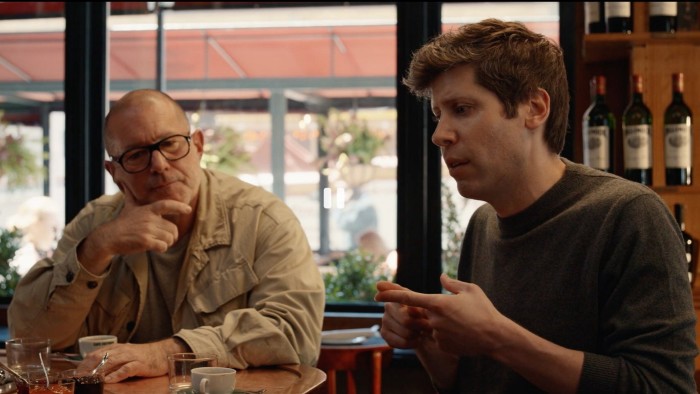Unlock the Editor’s Digest for free
Roula Khalaf, Editor of the FT, selects her favourite stories in this weekly newsletter.
The reverberations that ChatGPT sent through one of Silicon Valley’s most powerful technology empires say a lot about the nature of disruption in the tech industry. Google had seen off any number of would-be search engine rivals over the years, but here was something different and potentially much more threatening: an entirely new way to ask for information.
It is tempting to see this week’s attempt by OpenAI to plant its flag in the consumer hardware business as a similar challenge to another tech empire: Apple. As he announced the purchase of io, a tech hardware start-up co-founded by Jony Ive, along with an alliance with the former Apple design guru, OpenAI chief executive Sam Altman explicitly forecast an end to the era of smartphone dominance. Today’s “legacy” consumer gadgets, he said, were not well suited to a future shaped by AI.
Apple’s own struggles with artificial intelligence lend additional power to this narrative. In one of its most damaging setbacks in years, it has failed to come up with a set of AI features that it promised would transform the way people complete tasks on the iPhone.
Rounding out the story is Ive’s personal narrative, which has been front and centre in the way his alliance with OpenAI has been presented. He has shown regret for some of the negative effects of the iPhone, like smartphone addiction. What better way to atone than to come up with a new set of gadgets that are more conducive to human flourishing?
All of this makes for an attractive David vs Goliath story. But there are good reasons to question whether OpenAI’s news this week represents a turning point for consumer hardware.
Start with the fact that its $6.5bn purchase of Ive’s start-up does not even involve the hiring of the former Apple designer himself. The other three founders, all from Apple, are part of a 55-person team that will be joining OpenAI, at the staggering cost of nearly $120mn a head. Ive himself will be a consultant along with his personal design firm, LoveFrom. OpenAI watchers may wonder what is new here: Altman has talked before about his close relationship with Ive and how the two were working on breakthrough ideas for AI-centric gadgets.
The impact that io’s small team is likely to have inside the AI company is a second reason for scepticism. On its own, this is unlikely to kick-start a design and hardware division capable of challenging the industry’s best. Apple’s innovations have come from deep investments in both the many component technologies involved, as well as the advanced manufacturing techniques needed to package these into must-have devices.
Equally important was the culture Steve Jobs built in the years leading up to the iPhone, with hardware design at the centre. Grafted on to an AI research lab that is transforming itself rapidly into a consumer tech giant, the new hardware group at OpenAI starts from a very different position.
The biggest reason to question whether OpenAI is about to disrupt Apple in hardware, though, is the nature of artificial intelligence itself. Unlike previous generations of technology, it may simply not lend itself to a breakout device. Compare the anticipation around AI now with the expectations that built up around mobile computing in the years before the launch of the iPhone. There was a widespread belief at the time that the industry was only one breakthrough away from putting the internet into people’s pockets. It just was not clear what that breakthrough would be — until the moment in 2007 when Jobs held up the first iPhone.
A similar expectation has been building around the hunt for a post-smartphone computing platform, with AI a key enabling technology. However, there is unlikely to be an “‘iPhone moment” for AI hardware. To be effective, artificial intelligence needs to be everywhere and nowhere. It needs to be in every device, enhancing every type of digital experience. But it also needs to retreat into the background, anticipating and completing tasks behind the scenes.
This suggests there will not be one single hardware form-factor capable of turning AI into a hit consumer product. Instead, the technology looks set to give a lift to a range of new markets, from smart glasses to inconspicuous “wearables”, while also adding extra value to the gadgets people already use most in their lives. The biggest opportunity for OpenAI lies in using its AI to animate all of these devices.
